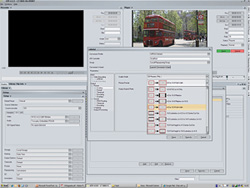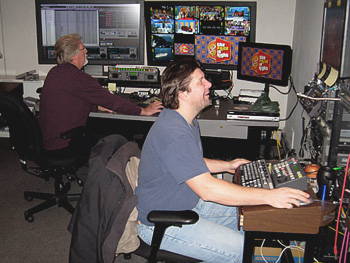The Legacy of Standard-Def
SEATTLE
With the delayed digital transition for broadcasters now about a month away, the move to high definition newscasts is still in stutter-step.
In some markets, where HD news is a point of competition, several stations have made the move to produce their newscasts in hi def. For others, HD newscasts may be many years away. Some are in-between, producing the studio portion of the newscast in HD but bringing in their field footage in standard definition.
But even when all stations are delivering their news in HD, SD content will play a role: stations are sitting on upwards of 60 years of archive footage— some of it dating back to 16mm film— most of it from the pre-digital age, that will keep finding its way into HD newscasts. For the foreseeable future, that material will need to be integrated into the HD workflow in those newsrooms.
And in the meantime, there will be SD traffic cameras, viewer-generated content, and other non-HD material that will need to be put into HD newscasts. Live content that arrives in an SD format will be upconverted as it is aired, but news packages will wend their way through a station's editing workflow.
WORKFLOW ISSUES
Technically speaking, turning SD material into HD is a simply stated—if not simply done—process: you roughly double the number of SD lines of resolution into 1080 lines and continue to present them in an interlace scan, or you not quite double them to 720 lines, and present them with a progressive scan. The quality of that process is paramount, though not for discussion here. We're here to talk editing workflow.
(click thumbnail)
Amberfin’s iCR software creates high quality file based masters, delivers quality control review and unique file conversion to multiple formats and simultaneously prepares multiplatform versions of video content.Telestream's Director of Product Marketing Anna Greco stated the challenge that the group of transcoding and editing vendors face: "What we're trying to do is come up with a workflow where material from disparate places and devices can be brought together in a very easy way, so that when they actually do the newscast they can pull in what they want without having to, for each piece, go through a bunch of manipulations."
Starting at the beginning of the editing workflow, that means that an editor should only have to think about what a piece of video content will contribute to the package he's editing, not what format it was shot in. "Detection of all video input standards is completely automated," said Bruce Devlin, chief technical officer at Amberfin, a recent spinoff from Snell & Wilcox.
It's more complicated than just discovering the SD material is, for example, from DV tape, said Devlin. "We try to pull out its various interlace features, which flavor of DV it was, what color sampling you had, whether it was the U.S. system or the European System." Any metadata is also retrieved.
Depending on how old the material is, it can get more complicated. If the images are still only on film, a film-to-video transfer has to be done. (If the station doesn't still have a film-chain, the editor better not be in a hurry. The film may well have to be sent to a specialty facility, often out of town.)
"If it was shot in composite in the '70s and '80s, you're talking about cleaning that material up somehow, and getting it into the digital domain," said Joe Zaller, vice president, corporate development at Snell & Wilcox.
There's also a most modern kind of content, what could be termed "SSD" (sub-standard definition) material, to deal with.
"Cellphone material [from viewers] is becoming quite popular these days," said Sam Lee, director of development, news and editing for Harris Broadcast Communications Division. "That also has to be combined into your output of HD."
The good news is that as long as the non-HD and HD material are both in digital form, "you can mix both formats on the timeline," said Jim Frantzreb, senior market segment manager, broadcast for Avid Technology. "The supporting infrastructure is really transparent."
What kind of HD you want to come out is a simpler matter, once a few decisions are made. Some of those decisions are more or less made for you. If your station is a 1080i station, chances are pretty good that you'll want your HD output to be in 1080i, and 720p for a 720p station.
If the editing equipment in the station uses a particular format, say DNX, then the content will be converted to that flavor of HD. That configuration can be made default in the system, and the editor never has to think about them.
ASPECT RATIO
Several vendors interviewed for this story pointed out that the biggest decision a station has to make is how to handle the discrepancy between SD's 4:3 and HD's 16:9 aspect ratio. A station may choose to stretch SD horizontally to fill out the sides, and to either do the stretching evenly across the frame, or to keep the center portion proportionally correct and gradually make up the difference on the sides.


CBS Television City uses Harris Nexio servers and Velocity NLE systems for the production of "The Price is Right" in HD. A popular technique in Europe is to zoom in to fill the sides, losing the image material at the top and bottom. Depending on the picture, the editor can save a little more of the top and lose more of the bottom, or vice versa.
But many stations choose to keep the SD upconverted material in its proportionally correct 4:3 aspect ratio. This leaves 12.5-percent of the 16:9 frame on each side of the 4:3 image, vertical rectangles that have become known as "pillars." "[The visual material] inserted into the pillars could come from a graphics engine, or from a clip player," said Jean-Claude Krelic, sales application specialist for infrastructure products for Miranda Technologies in Montreal.
Ed Casaccia, director of product marketing for servers and digital production at Grass Valley pointed out a complication that can keep stations from applying a particular design-look to the pillars of an upconverted 4:3 SD clip and calling it done. "Some stations go so far as to where each newscast has its own look. There's a 5:00 look, a 6:00 look, and an 11:00 look as to what goes into those pillars."
Not only might the station have four or so looks for the pillars at any one point in time, but it's almost guaranteed that in 18 months the station's branding look will change altogether, and along with that will come a new set of graphic applications for the pillars.
All the vendors TV Technology spoke with for this story emphasized that ongoing product support is one of the most important aspects of equipment that integrates SD material into HD newscasts. "There may not be a replacement for H.264 or MPEG-2 [compression formats] in the next year," said John Pallet, Telestream senior product manager, "but I can guarantee there will be new variants of ways of wrapping both SD and HD formats."
Amberfin's Devlin said that signal conversion vendors have to keep an eye on other equipment in the workflow chain. "When the editing vendors or play-out server vendors upgrade their software, one of the things we transcode vendors have to do is go through a whole revalidation process to make certain that the files we're transcoding still work with the new software our partners are deploying."
SD (and SSD) video material will continue to be a part of HD newscasts and other productions for many years ahead. Vendors involved with the workflow that integrate that material don't want the editors to have to think about it.
Get the TV Tech Newsletter
The professional video industry's #1 source for news, trends and product and tech information. Sign up below.
